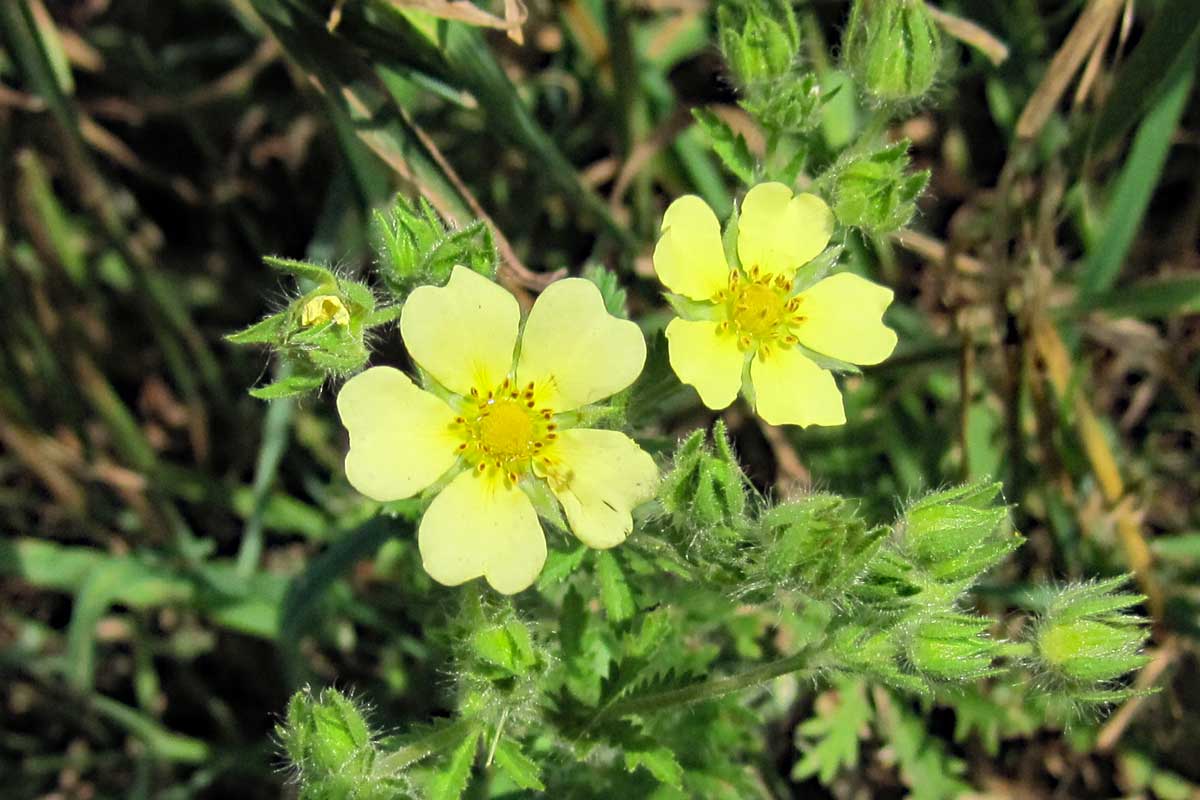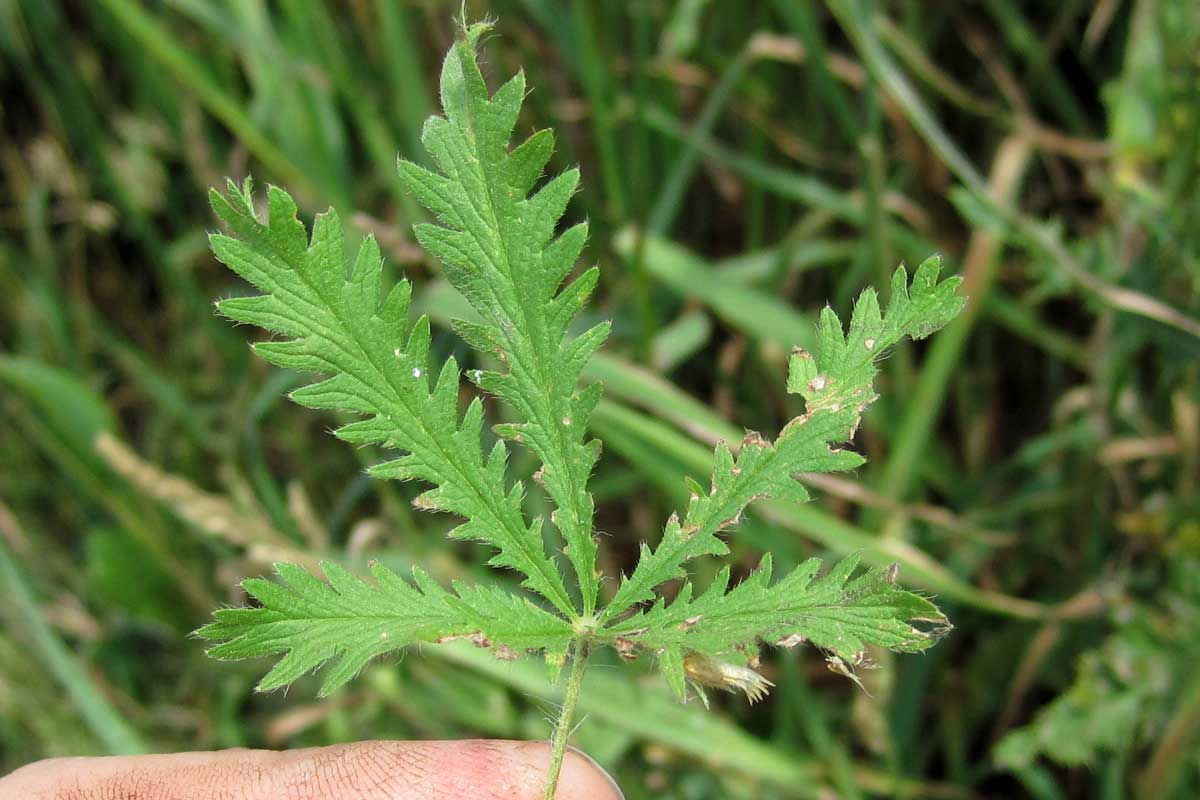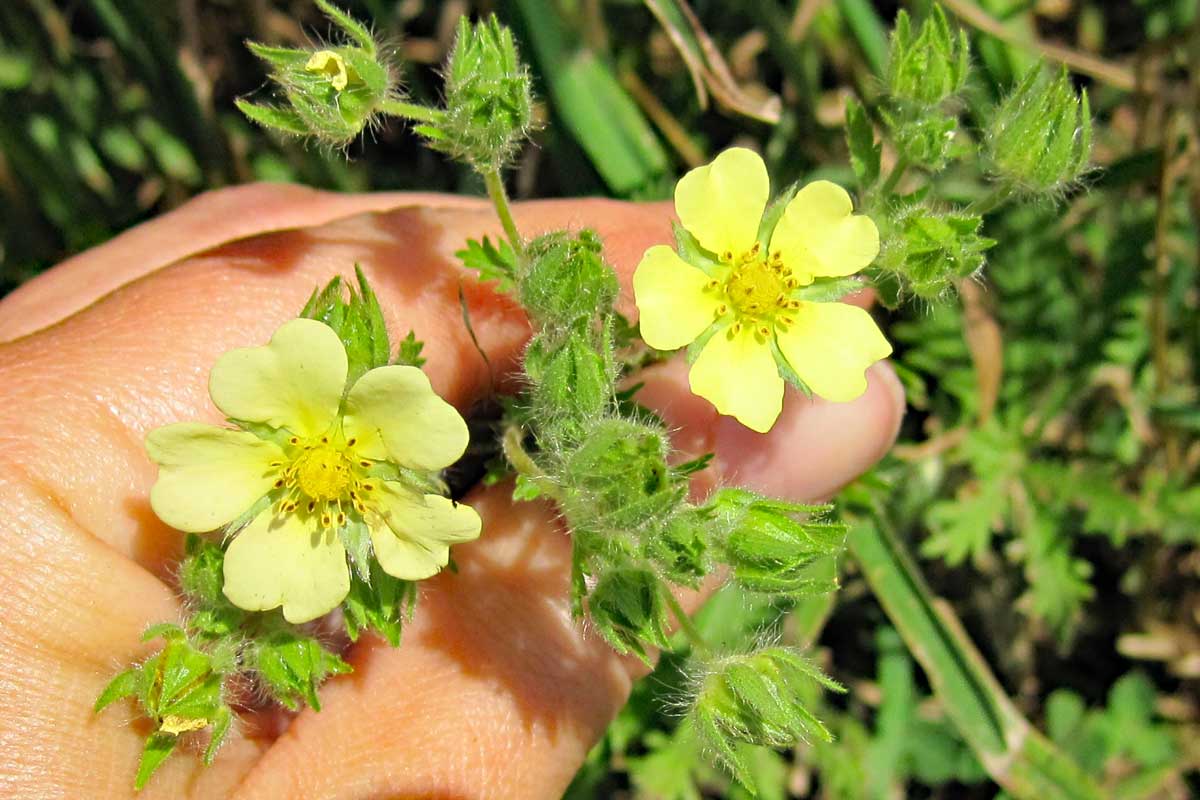Sulphur Cinquefoil: ID, Uses & Organic Control Tips
This post may contain affiliate links. Read my full disclosure here.
Sulphur cinquefoil, also spelled “sulfur cinquefoil”, is a deep-rooted perennial plant related to wild strawberries. Introduced from Eurasia in the 1900s, it now colonizes pastures, disturbed sites, and even healthy wild areas.
While it’s a persistent nuisance for some landowners, it also holds clues to what’s happening in your soil. It even has a few uses if you know what you’re looking at.

Table of contents
What Sulphur Cinquefoil Looks Like
Sulphur cinquefoil (Potentilla recta) stands 1–3 feet tall with stiff, hairy stems. The palmate leaves look a bit like marijuana, but are completely unrelated. The plant blooms from late spring through mid-summer with five-petaled, pale yellow flowers about an inch across.
Sulfur cinquefoil is native to the eastern Mediterranean region of Eurasia, but can now be found throughout most of the United States and Canada. It’s considered an invasive species in most of North America.
Quick ID Guide:
- Leaves: Palmately compound, 5–7 toothed leaflets, green on top, lighter and hairy underneath.
- Flowers: Pale yellow, heart-shaped petals, typically blooming May–July.
- Stems: Hairy, often branching above. Many stem leaves, but few basal leaves.
- Roots: Deep taproot with lateral roots and a woody crown.
- Seeds: has a net-like pattern on its seed coat.
It thrives in dry, compacted soils with little competition. It’s often one of the first plants to colonize abandoned or disturbed sites. I get them showing up around our gravel driveway, and in the dry soil of our retaining wall beds.
Reproduction and Spread
Sulfur cinquefoil reproduces by seed, with each plant capable of producing up to 1,600 seeds per year. Seeds remain viable in the soil for several years. Because of its woody root crown, the plant can also regrow if not fully removed, which makes control tricky without a long-term plan.
Wildlife and Traditional Uses
While sulphur cinquefoil is often labeled a noxious weed, it’s not without value. Like many so-called “weeds,” it has played a role in both natural ecosystems and traditional herbal practices.
Wildlife Value
While livestock avoid it due to its high tannin content, sulphur cinquefoil provides nectar for pollinators, including bees and butterflies. However, it can displace more beneficial native plants that offer better forage or habitat.
Though related to wild strawberries, the tiny fruits that form on them have very little flavor. I tried some and can see why the critters ignore them.
Traditional & Historic Herbal Uses
Historically, members of the Potentilla genus (which includes sulphur cinquefoil) were used in folk remedies:
- Astringent properties made it a remedy for diarrhea, wounds, and sore throats.
- Leaves were sometimes used in poultices for skin irritation.
- Some sources report use in tea or tincture form.
- Avoid extended use due to high tannin content.
The study, “Anti-inflammatory activity and phenolic composition of a traditional medicinal plant from Turkey: Potentilla recta” notes that the plant is traditionally used for its antibacterial, anti-inflammatory effects and as a tonic in Turkey. Results of the study support the traditional uses.
In the book “Edible & Medicinal Wild Plants of the Midwest“, the author notes that he uses cinquefoil tea for mouth soreness, due to the high tannin content. He also uses potentilla tincture for rotavirus in children, in combination with giant hyssop tea, and as part of his protocol for Grave’s disease. (Side note – this book is beautiful, and one of my favorites for wild plant information.)
What This Plant Says About Your Soil
In the book When Weeds Talk by Jay L. McCaman, sulphur cinquefoil is a classic indicator of imbalanced soils. When this weed shows up, your soil may have:
Would you like to save this?
- Very low calcium
- High phosphorus, potassium, magnesium, manganese, iron, and sulfates
- High aluminum levels
- Low porosity
- Low bacterial activity
These conditions often arise in degraded soils, especially in overgrazed pastures or fields that have been compacted or over-fertilized.
Organic Soil Improvement Strategies
If sulphur cinquefoil is showing up on your property, here’s how to respond using organic and regenerative methods:
1. Address the Mineral Imbalances
- Add soft rock phosphate with caution only if tests show low calcium but not high phosphorus.
- Apply high-calcium lime (like calcium carbonate) if calcium is low and magnesium is high.
- Use gypsum (calcium sulfate) to add calcium without raising pH if aluminum is high.
- Consider a full soil test to get an accurate snapshot before applying amendments.
Learn more about organic fertilizers.
2. Increase Biological Activity
- Apply compost or compost tea to boost bacterial populations.
- Mulch with natural materials to encourage worm activity and improve porosity.
- Use cover crops like clover or buckwheat to rebuild soil life and reduce compaction.
3. Improve Soil Structure
- Aerate compacted soil manually or with deep-rooting cover crops like daikon radish.
- Avoid tilling unless absolutely necessary, and focus on no-till or low-till practices.
- Add organic matter like aged manure or leaf mold to improve drainage and porosity.
Mechanical and Cultural Control Options
- Hand Pulling: Small patches can be removed by hand, but be sure to remove the entire root crown.
- Cutting or Mowing is not effective—it tends to stimulate new shoots.
- Smother Cropping: Use dense cover crops to reduce sunlight and outcompete seedlings.
- Rotational Grazing: Prevent overgrazing, which gives sulphur cinquefoil space to take hold.
Currently, there are no approved biological control methods for sulphur cinquefoil in the United States.
Don’t toss pulled plants into the compost if seeds are present. Instead bag and trash them, or burn where permitted.
Other Names
Other common names include:
- rough-fruited cinquefoil
- roughfruit cinquefoil
- upright cinquefoil
- erect cinquefoil
- five-finger cinquefoil
- yellow cinquefoil
Final Thoughts
Sulphur cinquefoil is more than just an eyesore—it’s a signal from your soil. Instead of just pulling it up year after year, take a closer look at your soil health. With thoughtful management and a bit of persistence, you can bring your land back into balance and crowd out this opportunistic plant.

This article is written by Laurie Neverman. Laurie was raised on a small dairy farm in northwest Wisconsin, where she gathered wildflowers from the woods and pastures. She and her family now live in northeast Wisconsin, where they combine intentional plantings and semi-wild areas. Every season is a new opportunity to learn more about working with wild plants.
Originally published in 2012, last updated in 2025.




Perfect timing! I just this morning noticed these coming up in profusion! I also noticed that there is a much higher density of wild strawberry all over our property where we often see it, though a little later than this year, as well as where we can’t remember seeing it before. I got as far as reflecting that we had our mud season earlier and for longer than usual. The bad news is that they are appearing where we are also seeing the sulfur cinqefoil, and I am the sole designated weeder on the property. Do you think adjusting the chemistry of our pasture areas will tend to eliminate the wild strawberries? I had visions of our hens gamboling around their foraging areas gobbling wild strawberries. Noetheless, it is great to have so many strategies to pursue in managing this rascal!
Every plant tells a story of the soil and weather conditions. Adjusting soil chemistry should indeed have an impact, though I haven’t specifically investigated the “fixes” for an excess of wild strawberries, since we don’t have them on our current property.
Hello! Have you ever tasted the Sulphur Cinquefoil yourself? It’s definitely not bitter! I don’t think it has a high tannin content. But my goats will eat it it!
Thanks for the feature M xx
Very timely post for me…this week I had a medical procedure, and the doctor and nurses were discussing potentilla! They described it and I thought I’d figure out what it is once I got home. After seeing this post, I recognize it and know I have it at my place too!
What condition did they want to treat with potentilla?